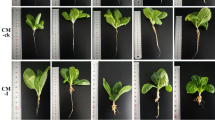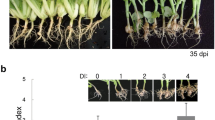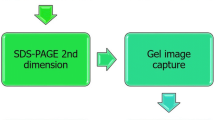Abstract
High-throughput functional proteomics assay was conducted to investigate post-transcriptional changes in plant proteins upon interactions between Chinese cabbage (Brassica rapa subsp. pekinensis) and the clubroot pathogen Plasmodiophora brassicae. Protein profiles between infected and uninfected clubroot-susceptible plants of different genotypes at 10 days after inoculation (DAI) were compared and consolidated. A total of 295 proteins, functioning in energy and lipid metabolism, plant defense, cell wall modification, and hormone biosynthesis and signaling, were found to be differentially expressed during the secondary phase of the Chinese cabbage-P. brassicae interaction. It is worth noting that upregulation of proteins involved in brassinosteroids (BR) metabolism was confirmed: cycloartenol synthase (CAS1) and cytochrome P450 51G1 (CYP51G1), which are deeply involved in BR biosynthesis, were upregulated after inoculation. Furthermore, the treatment of P. brassicae-infected Chinese cabbage plants with an inhibitor of cycloartenol synthase resulted in reduced root gall size, revealing a contribution of CAS1 to clubroot development. These results demonstrated important aspects of the Chinese cabbage-P. brassicae interactions and might lead to the identification of key regulators in the BR pathway involved in clubroot development.







Similar content being viewed by others
References
Agarwal A, Kaul V, Faggian R, Rookes JE, Ludwigmüller J, Cahill DM (2011) Analysis of global host gene expression during the primary phase of the Arabidopsis thaliana-Plasmodiophora brassicae interaction. Funct Plant Biol 38:462–478
Alvarez S, Berla BM, Sheffield J, Cahoon RE, Jez JM, Hicks LM (2009) Comprehensive analysis of the Brassica juncea root proteome in response to cadmium exposure by complementary proteomic approaches. Proteomics 9:2419–2431
Ando S, Tsushima S, Tagiri A, Kamachi S, Konagaya K, Hagio T, Yutaka T (2006) Increase in BrAO1 gene expression and aldehyde oxidase activity during clubroot development in Chinese cabbage Brassica rapa. Mol Plant Pathol 7:223–234
Andrews GL, Simons BL, Young JB, Hawkridge AM, Muddiman DC (2011) Performance characteristics of a new hybrid triple quadrupole time-of-flight tandem mass spectrometer. Anal Chem 83:5442–5446
Barth C, Jander G (2006) Arabidopsis myrosinases TGG1 and TGG2 have redundant function in glucosinolate breakdown and insect defense. Plant J 46:549–562
Bergh GV (2006) Two-dimensional difference gel electrophoresis. Nat Protoc 1:1351–1358
Boyd LA (2006) Can the durability of resistance be predicted? J Sci Food Agric 86:2523–2526
Brun H, Chèvre AM, Fitt BD, Powers S, Besnard AL, Ermel M, Huteau V, Marquer B, Eber F, Renard M, Andrivon D (2010) Quantitative resistance increases the durability of qualitative resistance to Leptosphaeria maculans in Brassica napus. New Phytol 185:285–299
Burow M, Markert J, Gershenzon J, Wittstock U (2006) Comparative biochemical characterization of nitrile-forming proteins from plants and insects that alter myrosinase-catalysed hydrolysis of glucosinolates. FEBS J 273:2432–2446
Candiano G, Bruschi M, Musante L, Santucci L, Ghiggeri GM (2004) Blue silver: a very sensitive colloidal Coomassie G-250 staining for proteome analysis. Electrophoresis 25:1327–1333
Cao TS, Srivastava S, Rahman MH, Nnv K, Hotte N, Deyholos MK, Stephen E (2008) Proteome-level changes in the roots of Brassica napus as a result of Plasmodiophora brassicae infection. Plant Sci 174:97–115
Chen J, Jing J, Zhan Z, Zhang T, Zhang C, Piao Z (2013) Identification of novel QTLs for isolate-specific partial resistance to Plasmodiophora brassicae in Brassica rapa. PLoS One 8:e85307
Devos S, Laukens K, Deckers P, Van Der Straeten D, Beeckman T, Inzé D, Van Onckelen H, Witters E, Prinsen E (2006) A hormone and proteome approach to picturing the initial metabolic events during Plasmodiophora brassicae infection on Arabidopsis. Mol Plant-Microbe Interact 19:1431–1443
Dixon GR (2009) The occurrence and economic impact of Plasmodiophora brassicae and clubroot disease. J Plant Growth Regul 28:194–202
Dixon DP, Edwards R (2010) Glutathione transferases. The Arabidopsis Book, 8. The American Society of Plant Biologists, Rockville
Donald EC, Porter IJ (2004) A sand-solution culture technique used to observe the effect of calcium and pH on root hair and cortical stages of infection by Plasmodiophora brassicae. Australas Plant Pathol 33:585–589
Du Z, Zhou X, Ling Y, Zhang Z, Su Z (2010) Agrigo: a go analysis toolkit for the agricultural community. Nucleic Acids Res 38:W64–W70
Fenner GP, Raphiou I (1995) Growth of Cururbita maxima, L. plants in the presence of the cycloartenol synthase inhibitor U18666A. Lipids 30:253–256
Gigolashvili T, Kopriva S (2014) Transporters in plant sulfur metabolism. Front Plant Sci 5:442
Goda H, Sawa S, Asami T, Fujioka S, Shimada Y, Yoshida S (2004) Comprehensive comparison of auxin-regulated and brassinosteroid-regulated genes in Arabidopsis. Plant Physiol 134:1555–1573
Hammerschmidt R (1999) Phytoalexins: what have we learned after 60 years? Annu Rev Phytopathol 37:285–306
Hanafusa H, Ishikawa K, Kedashiro S, Saigo T, Iemura SI, Natsume T, Komada M, Shibuya H, Nara A, Matsumotoa K (2011) Leucine-rich repeat kinase LRRK1 regulates endosomal trafficking of the EGF receptor. Nat Commun 2:158
Hatakeyama K, Suwabe K, Tomita RN, Kato T, Nunome T, Fukuoka H, Matsumoto S (2013) Identification and characterization of Crr1a, a gene for resistance to clubroot disease (Plasmodiophora brassicae Woronin) in Brassica rapa. PLoS One 8:621–626
Hirai M, Harada T, Kubo N, Tsukada M, Suwabe K, Matsumoto S (2004) A novel locus for clubroot resistance in Brassica rapa and its linkage markers. Theor Appl Genet 108:639–643
Ingram DS, Tommerup IC (1972) The life history of Plasmodiophora brassicae Woron. Proc R Soc B Biol Sci 180:103–112
Jubault M, Lariagon C, Taconnat L, Renou JP, Gravot A, Delourme R, Manzanares-Dauleux M (2013) Partial resistance to clubroot in Arabidopsis is based on changes in the host primary metabolism and targeted cell division and expansion capacity. Funct Integr Genomics 13:191–205
Kachroo A, Lapchyk L, Fukushige H, Hildebrand D, Klessig D (2003) Plastidial fatty acid signaling modulates salicylic acid-and jasmonic acid-mediated defense pathways in the Arabidopsis ssi2 mutant. Plant Cell 15:2952–2965
Kobe B, Kajava AV (2001) The leucine-rich repeat as a protein recognition motif. Curr Opin Struct Biol 11:725–732
Lahlali R, Mcgregor L, Song T, Gossen BD, Narisawa K, Peng G (2014) Heteroconium chaetospira induces resistance to clubroot via upregulation of host genes involved in jasmonic acid, ethylene, and auxin biosynthesis. PLoS One 9:e94144
Liu Y, Schiff M, Dinesh SP (2004) Involvement of MEK1 MAPKK, NTF6 MAPK, WRKY/MYB transcription factors, COI1, and CTR1, in N -mediated resistance to tobacco mosaic virus. Plant J 38:800–809
Ludwig-Müller J (2009) Plant defence — what can we learn from clubroots? Australas Plant Pathol 38:318–324
Matsumoto E, Yasui C, Ohi M, Tsukada M (1998) Linkage analysis of RFLP markers for clubroot resistance and pigmentation in Chinese cabbage Brassica rapa ssp. pekinensis. Euphytica 104:79–86
Nie J, An L, Miao K, Hou Z, Yu Y, Tan K, Sui L, He S, Liu Q, Lei X, Wu Z, Tian J (2013) Comparative analysis of dynamic proteomic profiles between in vivo and in vitro produced mouse embryos during postimplantation period. J Proteome Res 12:3843–3856
Nomoto M, Tamura S (1970) Lsolation and identification of indole derivatives in clubroots of Chinese cabbage. Agric Biol Chem 34:1590–1592
Palloix A, Ayme V, Moury B (2009) Durability of plant major resistance genes to pathogens depends on the genetic background, experimental evidence and consequences for breeding strategies. New Phytol 183:190–199
Piao ZY, Deng YQ, Choi SR, Park YJ, Lim YP (2004) Scar and caps mapping of, crb, a gene conferring resistance to, Plasmodiophora brassicae, in Chinese cabbage Brassica rapa ssp. pekinensis. Theor Appl Genet 108:1458–1465
Qi J, Yu S, Zhang F, Shen X, Zhao X, Yu Y (2010) Reference gene selection for real-time quantitative polymerase chain reaction of mRNA transcript levels in Chinese cabbage Brassica rapa L. ssp. pekinensis. Plant Mol Biol Report 28:597–604
Sakamoto K, Saito A, Hayashida N, Taguchi G, Matsumoto E (2008) Mapping of isolate-specific QTLs for clubroot resistance in Chinese cabbage Brassica rapa L. ssp. pekinensis. Theor Appl Genet 117:759–767
Schuller A, Kehr J, Ludwigmüller J (2014) Laser microdissection coupled to transcriptional profiling of Arabidopsis roots inoculated by Plasmodiophora brassicae indicates a role for brassinosteroids in clubroot formation. Plant Cell Physiol 55:392–411
Schwelm A, Fogelqvist J, Knaust A, Jülke S, Lilja T, Bonillarosso G et al (2015) The plasmodiophora brassicae genome reveals insights in its life cycle and ancestry of chitin synthases. Sci Rep 5:11153
Shen XQ, Nie K, Wu Q, Zhang YG, Meng XH (2009) Initial research report on differentiation identification of Chinese cabbage clubroot main physiological races. China Veget 8:59–62
Siemens J, Nagel M, Ludwig-Müller J, Sacristán MD (2002) The interaction of Plasmodiophora brassicae, and Arabidopsis thaliana: parameters for disease quantification and screening of mutant lines. J Phytopathol 150:592–605
Siemens J, Keller I, Sarx J, Kunz S, Schuller A, Nagel W, Schmülling T, Parniske M, Ludwig-Müller J (2006) Transcriptome analysis of arabidopsis clubroots indicate a key role for cytokinins in disease development. Mol Plant-Microbe Interact 19:480–494
Siemens J, González MC, Wolf S, Hofmann C, Greiner S, Du Y, Rausch T, Roitsch T, Ludwig-Müller J (2011) Extracellular invertase is involved in the regulation of clubroot disease in Arabidopsis thaliana. Mol Plant Pathol 12:247–262
Song T, Chu M, Rachid L, Yu F, Peng G (2016) Shotgun label-free proteomic analysis of clubroot (plasmodiophora brassicae) resistance conferred by the gene Rcr1in brassica rapa. Front Plant Sci 7:1013
Stotz HU, Kroymann J, Mitchell-Olds T (1999) Plant-insect interactions. Curr Opin Plant Biol 2:268–272
Su T, Xu J, Li Y, Lei L, Zhao L, Yang H, Ren D (2011) Glutathione-indole-3-acetonitrile is required for camalexin biosynthesis in Arabidopsis thaliana. Plant Cell 23:364–380
Suwabe K, Tsukazaki H, Iketani H, Hatakeyama K, Fujimura M, Nunome T (2003) Identification of two loci for resistance to clubroot (Plasmodiophora brassicae Woronin) in Brassica rapa L. Theor Appl Genet 107:997–1002
Tanaka S, Ito SI (2013) Pathogenic and genetic diversity in Plasmodiophora brassicae (clubroot) from Japan. J Gen Plant Pathol 79:297–306
Tang X, Fu X, Hao B, Zhu F, Xiao S, Xu L, Shen Z (2014) Identification of sumoylated proteins in the silkworm Bombyx mori. Int J Mol Sci 15:22011–22027
Trujillo M, Shirasu K, Parker JE, Ellis JG (2010) Ubiquitination in plant immunity. Curr Opin Plant Biol 13:402–408
Wu WW, Wang G, Baek SJ, Shen RF (2006) Comparative study of three proteomic quantitative methods, DIGE, CICAT, and iTRAQ, using 2D gel- or LC-MALDI TOF/TOF. J Proteome Res 5:651–658
Xia XJ, Zhou YH, Shi K, Zhou J, Foyer CH, Yu JQ (2015) Interplay between reactive oxygen species and hormones in the control of plant development and stress tolerance. J Exp Bot 66:2839–2856
Yu T, Li G, Liu P, Dong S, Zhang J, Zhao B (2017) Proteomics analysis of maize Zea mays l. grain based on iTRAQ reveals molecular mechanisms of poor grain filling in inferior grains. Plant Physiol Biochem 115:83–96
Zhao P, Pei L, Shao J, Li C, Wang B, Xin G (2015) Analysis of different strategies adapted by two cassava cultivars in response to drought stress: ensuring survival or continuing growth. J Exp Bot 66:1477–1488
Acknowledgements
This work was supported by grants from the Natural Science Foundation of Beijing Municipality (6172008 and 6154025), the National Key Research and Development Program of China (2016YFD0100506), the Natural Science Foundation of China (31401875, 31772307, 31772297 and 31401867), the National Plan for Science & Technology Support (2015BAD02B02), the Foundation for Young Scientists of BAAFS (QNJJ201402 and QNJJ 201508).
Author information
Authors and Affiliations
Corresponding author
Ethics declarations
All experiments comply with the current laws of the country.
Conflict of interest
All authors declared to have full control of all primary data and agree to allow the journal to review our data if requested.
Rights and permissions
About this article
Cite this article
Su, T., Yu, S., Wang, W. et al. iTRAQ analysis of protein profile during the secondary stage of infection of Plasmodiophora brassicae in Chinese cabbage (Brassica rapa subsp. pekinensis). J Plant Pathol 100, 533–542 (2018). https://doi.org/10.1007/s42161-018-0121-z
Published:
Issue Date:
DOI: https://doi.org/10.1007/s42161-018-0121-z




